Valerio Avitabile
Astrophotography
Portfolio
The universe
in your eyes
Galaxies, nebulae, stars
in a single shot
How can i help you?
Customised online courses
Stacking, photo editing,
software, and other tips
Video & Utilities
Discover my videos and tools for astronomical calculations
Video & tutorial
Plate solve and other
About me
Astrofotography is a lifestile, a comunity, a way of being...
Do you have any questions?
Feel free to write to me, I will be happy to answer you. Select your favorite channels
Privacy Policy for valerioavitabile-astrophotographyPrivacy Policy
Last updated: October 03, 2025This Privacy Policy describes Our policies and procedures on the collection, use and disclosure of Your information when You use the Service and tells You about Your privacy rights and how the law protects You.We use Your Personal data to provide and improve the Service. By using the Service, You agree to the collection and use of information in accordance with this Privacy Policy. This Privacy Policy has been created with the help of the Free Privacy Policy Generator.Interpretation and Definitions
Interpretation
The words whose initial letters are capitalized have meanings defined under the following conditions. The following definitions shall have the same meaning regardless of whether they appear in singular or in plural.Definitions
For the purposes of this Privacy Policy:Account means a unique account created for You to access our Service or parts of our Service.Affiliate means an entity that controls, is controlled by, or is under common control with a party, where "control" means ownership of 50% or more of the shares, equity interest or other securities entitled to vote for election of directors or other managing authority.Company (referred to as either "the Company", "We", "Us" or "Our" in this Agreement) refers to valerioavitabile-astrophotography.Cookies are small files that are placed on Your computer, mobile device or any other device by a website, containing the details of Your browsing history on that website among its many uses.Country refers to: ItalyDevice means any device that can access the Service such as a computer, a cell phone or a digital tablet.Personal Data is any information that relates to an identified or identifiable individual.Service refers to the Website.Service Provider means any natural or legal person who processes the data on behalf of the Company. It refers to third-party companies or individuals employed by the Company to facilitate the Service, to provide the Service on behalf of the Company, to perform services related to the Service or to assist the Company in analyzing how the Service is used.Usage Data refers to data collected automatically, either generated by the use of the Service or from the Service infrastructure itself (for example, the duration of a page visit).Website refers to valerioavitabile-astrophotography, accessible from https://valerioavitabile-astrophotography.itYou means the individual accessing or using the Service, or the company, or other legal entity on behalf of which such individual is accessing or using the Service, as applicable.Collecting and Using Your Personal Data
Types of Data Collected
Personal Data
While using Our Service, We may ask You to provide Us with certain personally identifiable information that can be used to contact or identify You. Personally identifiable information may include, but is not limited to:Email addressUsage DataUsage Data
Usage Data is collected automatically when using the Service.Usage Data may include information such as Your Device's Internet Protocol address (e.g. IP address), browser type, browser version, the pages of our Service that You visit, the time and date of Your visit, the time spent on those pages, unique device identifiers and other diagnostic data.When You access the Service by or through a mobile device, We may collect certain information automatically, including, but not limited to, the type of mobile device You use, Your mobile device's unique ID, the IP address of Your mobile device, Your mobile operating system, the type of mobile Internet browser You use, unique device identifiers and other diagnostic data.We may also collect information that Your browser sends whenever You visit Our Service or when You access the Service by or through a mobile device.Tracking Technologies and Cookies
We use Cookies and similar tracking technologies to track the activity on Our Service and store certain information. Tracking technologies We use include beacons, tags, and scripts to collect and track information and to improve and analyze Our Service. The technologies We use may include:Cookies or Browser Cookies. A cookie is a small file placed on Your Device. You can instruct Your browser to refuse all Cookies or to indicate when a Cookie is being sent. However, if You do not accept Cookies, You may not be able to use some parts of our Service. Unless you have adjusted Your browser setting so that it will refuse Cookies, our Service may use Cookies.
Web Beacons. Certain sections of our Service and our emails may contain small electronic files known as web beacons (also referred to as clear gifs, pixel tags, and single-pixel gifs) that permit the Company, for example, to count users who have visited those pages or opened an email and for other related website statistics (for example, recording the popularity of a certain section and verifying system and server integrity).
Cookies can be "Persistent" or "Session" Cookies. Persistent Cookies remain on Your personal computer or mobile device when You go offline, while Session Cookies are deleted as soon as You close Your web browser. Learn more about cookies on the Free Privacy Policy website article.We use both Session and Persistent Cookies for the purposes set out below:Necessary / Essential CookiesType: Session CookiesAdministered by: UsPurpose: These Cookies are essential to provide You with services available through the Website and to enable You to use some of its features. They help to authenticate users and prevent fraudulent use of user accounts. Without these Cookies, the services that You have asked for cannot be provided, and We only use these Cookies to provide You with those services.Cookies Policy / Notice Acceptance CookiesType: Persistent CookiesAdministered by: UsPurpose: These Cookies identify if users have accepted the use of cookies on the Website.Functionality CookiesType: Persistent CookiesAdministered by: UsPurpose: These Cookies allow us to remember choices You make when You use the Website, such as remembering your login details or language preference. The purpose of these Cookies is to provide You with a more personal experience and to avoid You having to re-enter your preferences every time You use the Website.For more information about the cookies we use and your choices regarding cookies, please visit our Cookies Policy or the Cookies section of our Privacy Policy.Use of Your Personal Data
The Company may use Personal Data for the following purposes:To provide and maintain our Service, including to monitor the usage of our Service.To manage Your Account: to manage Your registration as a user of the Service. The Personal Data You provide can give You access to different functionalities of the Service that are available to You as a registered user.For the performance of a contract: the development, compliance and undertaking of the purchase contract for the products, items or services You have purchased or of any other contract with Us through the Service.To contact You: To contact You by email, telephone calls, SMS, or other equivalent forms of electronic communication, such as a mobile application's push notifications regarding updates or informative communications related to the functionalities, products or contracted services, including the security updates, when necessary or reasonable for their implementation.To provide You with news, special offers, and general information about other goods, services and events which We offer that are similar to those that you have already purchased or inquired about unless You have opted not to receive such information.To manage Your requests: To attend and manage Your requests to Us.For business transfers: We may use Your information to evaluate or conduct a merger, divestiture, restructuring, reorganization, dissolution, or other sale or transfer of some or all of Our assets, whether as a going concern or as part of bankruptcy, liquidation, or similar proceeding, in which Personal Data held by Us about our Service users is among the assets transferred.For other purposes: We may use Your information for other purposes, such as data analysis, identifying usage trends, determining the effectiveness of our promotional campaigns and to evaluate and improve our Service, products, services, marketing and your experience.We may share Your personal information in the following situations:With Service Providers: We may share Your personal information with Service Providers to monitor and analyze the use of our Service, to contact You.
For business transfers: We may share or transfer Your personal information in connection with, or during negotiations of, any merger, sale of Company assets, financing, or acquisition of all or a portion of Our business to another company.
With Affiliates: We may share Your information with Our affiliates, in which case we will require those affiliates to honor this Privacy Policy. Affiliates include Our parent company and any other subsidiaries, joint venture partners or other companies that We control or that are under common control with Us.
With business partners: We may share Your information with Our business partners to offer You certain products, services or promotions.
With other users: when You share personal information or otherwise interact in the public areas with other users, such information may be viewed by all users and may be publicly distributed outside.
With Your consent: We may disclose Your personal information for any other purpose with Your consent.
Retention of Your Personal Data
The Company will retain Your Personal Data only for as long as is necessary for the purposes set out in this Privacy Policy. We will retain and use Your Personal Data to the extent necessary to comply with our legal obligations (for example, if we are required to retain your data to comply with applicable laws), resolve disputes, and enforce our legal agreements and policies.The Company will also retain Usage Data for internal analysis purposes. Usage Data is generally retained for a shorter period of time, except when this data is used to strengthen the security or to improve the functionality of Our Service, or We are legally obligated to retain this data for longer periods.Transfer of Your Personal Data
Your information, including Personal Data, is processed at the Company's operating offices and in any other places where the parties involved in the processing are located. It means that this information may be transferred to — and maintained on — computers located outside of Your state, province, country or other governmental jurisdiction where the data protection laws may differ from those from Your jurisdiction.Your consent to this Privacy Policy followed by Your submission of such information represents Your agreement to that transfer.The Company will take all steps reasonably necessary to ensure that Your data is treated securely and in accordance with this Privacy Policy and no transfer of Your Personal Data will take place to an organization or a country unless there are adequate controls in place including the security of Your data and other personal information.Delete Your Personal Data
You have the right to delete or request that We assist in deleting the Personal Data that We have collected about You.Our Service may give You the ability to delete certain information about You from within the Service.You may update, amend, or delete Your information at any time by signing in to Your Account, if you have one, and visiting the account settings section that allows you to manage Your personal information. You may also contact Us to request access to, correct, or delete any personal information that You have provided to Us.Please note, however, that We may need to retain certain information when we have a legal obligation or lawful basis to do so.Disclosure of Your Personal Data
Business Transactions
If the Company is involved in a merger, acquisition or asset sale, Your Personal Data may be transferred. We will provide notice before Your Personal Data is transferred and becomes subject to a different Privacy Policy.Law enforcement
Under certain circumstances, the Company may be required to disclose Your Personal Data if required to do so by law or in response to valid requests by public authorities (e.g. a court or a government agency).Other legal requirements
The Company may disclose Your Personal Data in the good faith belief that such action is necessary to:Comply with a legal obligation
Protect and defend the rights or property of the Company
Prevent or investigate possible wrongdoing in connection with the Service
Protect the personal safety of Users of the Service or the public
Protect against legal liability
Security of Your Personal Data
The security of Your Personal Data is important to Us, but remember that no method of transmission over the Internet, or method of electronic storage is 100% secure. While We strive to use commercially reasonable means to protect Your Personal Data, We cannot guarantee its absolute security.Children's Privacy
Our Service does not address anyone under the age of 13. We do not knowingly collect personally identifiable information from anyone under the age of 13. If You are a parent or guardian and You are aware that Your child has provided Us with Personal Data, please contact Us. If We become aware that We have collected Personal Data from anyone under the age of 13 without verification of parental consent, We take steps to remove that information from Our servers.If We need to rely on consent as a legal basis for processing Your information and Your country requires consent from a parent, We may require Your parent's consent before We collect and use that information.Links to Other Websites
Our Service may contain links to other websites that are not operated by Us. If You click on a third party link, You will be directed to that third party's site. We strongly advise You to review the Privacy Policy of every site You visit.We have no control over and assume no responsibility for the content, privacy policies or practices of any third party sites or services.Changes to this Privacy Policy
We may update Our Privacy Policy from time to time. We will notify You of any changes by posting the new Privacy Policy on this page.We will let You know via email and/or a prominent notice on Our Service, prior to the change becoming effective and update the "Last updated" date at the top of this Privacy Policy.You are advised to review this Privacy Policy periodically for any changes. Changes to this Privacy Policy are effective when they are posted on this page.Contact Us
If you have any questions about this Privacy Policy, You can contact us:By email: [email protected]

ABOUT ME
Amateur astrophotographer, born in 1976, I have always been fascinated by the cosmos and its mysteries.
In 2018, I assembled my first astronomical equipment, finally opening my eyes to horizons that until then had only been reached by my imagination.
From my first shots with an SLR camera to the evolution towards modern CMOS sensors, each photo has become a journey into the cosmos for me, among photons and wonder.Over time, I have assimilated knowledge, constantly experimenting and perfecting shooting and post-production techniques.
I have seen my images travel far and wide, recognized and published internationally: from the NASA APOD selection to mentions on Astrobin, to winning the Optolong 2021 global contest.
All of this, strictly captured from my terrace at home, proves that with commitment and passion, the cosmos can be within everyone's reach.Today, I am pleased to make my acquired skills available to the community, offering personalized online courses for those who want to get started in astrophotography or perfect their technique, with the aim of sharing knowledge, sparking curiosity, and helping others to look up at the stars.
HOW CAN I HELP YOU?
I have transformed my passion for processing into a clear and effective teaching method.
In my ONLINE COURSES, I will teach you my complete workflow for transforming a simple RAW file into a spectacular astronomical photograph.Together, we will go through every step of the process: from stacking to removing gradients, stretching the image, and managing color with powerful tools such as PIXINSIGHT, PHOTOSHOP, and CAMERA RAW. This course is designed for both beginners and those who want to discover alternative techniques.
CLICK HERE to contact me through your preferred channels and get more information.
The video shows an example of how raw data can be transformed into a stunning final image
COURSE TOPIC
We will learn how to manage our raw files
and get to the final image
■ Image stacking, calibration with dark, flat, darkflat
■ Creation and calibration of RGB channels
■ Gradient removal, photometric color calibration, starless image
■ Deconvolution and linear denoising
■ Stretching and non-linear fase
■ Curves, contrasts, saturation, blending modes
■ Definition of fine details, star color calibration, final image
■ Questions, reflections, release of the video lesson
Galaxies
Galaxies are vast collections of stars, gas, dust, and dark matter, held together by gravity, which can contain from millions to trillions of stars, planetary systems, nebulae, and black holes. They represent the main components of the observable universe and come in different shapes and sizes. Our Milky Way is a barred spiral galaxy, characterized not only by spiral arms but also by a central bar of stars that runs through its core, unlike "normal" spiral galaxies which have a compact nucleus. Composed of older stars, this central bar acts as a channel that transports gas and materials toward the galactic center, where star formation and phenomena related to the supermassive black hole take place.
Bright Nebulae
A nebula is an interstellar cluster of dust, hydrogen, and plasma, classified into different types. Reflection nebulae shine by reflecting the light of nearby stars, while emission nebulae emit their own light.
Their color depends on chemical composition: red indicates an abundance of hydrogen, while blue-green hues signal the presence of other elements.
Considered true "star factories," within them, gas and dust interact with gravity, triggering the processes that lead to the birth of new stars.
Wolf Rayet
Wolf-Rayet (WR) are massive, hot stars in the final stages of their evolution, discovered in 1867 by French astronomers Charles Wolf and Georges Rayet. With masses ranging from 5 to over 20 times that of the Sun, they emit intense radiation, especially in the ultraviolet range.
Having exhausted the hydrogen in their core, they fuse heavier elements like helium and carbon, becoming extremely hot. This tremendous energy generates powerful stellar winds that eject large amounts of matter into space at speeds of thousands of kilometers per second. This mass loss process contributes to the formation of circumstellar nebulae composed of gas and dust.
Star Clusters
Star clusters are groups of stars born from the same cloud of gas and dust, bound together by gravity, and are divided into open clusters and globular clusters. Open clusters, such as the Pleiades and Hyades, are young, contain a few hundred to a few thousand stars, and are located in the galaxy's disk, with an irregular and bright arrangement. Globular clusters, like Omega Centauri, are billions of years old, contain hundreds of thousands of stars densely packed in a spherical shape, and are found in the galactic halo, representing some of the oldest structures in the universe.
Hubble Palette
The Hubble Palette is a color mapping technique used in astrophotography to highlight the structure and composition of celestial objects. It assigns red to sulfur-II (SII) emissions, green to hydrogen-alpha (Hα), and blue to oxygen-III (OIII), based on narrowband filters. Popularized by the Hubble Space Telescope, this palette is not true to natural color but emphasizes the distribution of elements and processes in nebulae. Iconic images like the Pillars of Creation showcase its ability to reveal intricate details. Widely used by both professional and amateur astrophotographers, the Hubble Palette creates striking, high-contrast images that combine scientific insight with visual appeal.
Dark Nebulae
A dark nebula, or molecular cloud, is a vast and cold cloud composed mainly of gas and a small fraction of dust. Its dark appearance is caused by this dust, which absorbs the light from stars or nebulae behind it, especially the blue part of the spectrum.
These clouds are among the coldest objects in the universe and are visible as dark silhouettes against luminous backgrounds. The largest, known as giant molecular clouds, can reach a mass a million times that of the Sun. With their irregular shapes, they are visible to the naked eye as dark patches against the glow of the Milky Way.
Supernova remnant
A supernova remnant is the material ejected from a violent stellar explosion. This phenomenon occurs when a very massive star exhausts its fuel and collapses, or when a white dwarf accumulates too much mass from a companion star.
In both cases, the explosion hurls the star's outer layers into space at extremely high speeds, creating an expanding cloud of gas and dust. The star's core, however, can collapse to form a compact object like a neutron star or a black hole. While the cloud dissipates over thousands of years, these compact remnants are nearly eternal.
Planetary Nebulae
Planetary nebulae are a transitional phase in the life of low- to medium-mass stars. They form when a dying star expels its outer layers, leaving behind a hot, dense core that will become a white dwarf.
The core's ultraviolet radiation ionizes the surrounding gas, causing it to glow with vibrant colors that indicate the presence of elements like hydrogen and oxygen. Despite their name, they have no relation to planets.
With a short lifespan of tens of thousands of years, these variously shaped structures enrich the interstellar medium with heavy elements, essential for the formation of new stars. Our Sun will also form one in about 5 billion years.
VIDEO & TUTORIALS
M33 Triangulum Galaxy
The Triangulum Galaxy, also known as Messier 33 or M33, is a spiral galaxy located in the constellation Triangulum.
At an approximate distance of 2.73 million light-years from Earth and with a diameter of 18.74 kiloparsecs (about 61,100 light-years), the Triangulum Galaxy is the third-largest member of the Local Group of galaxies, following the Andromeda Galaxy and the Milky Way. It is composed of countless clusters of young blue stars that illuminate its swirling arms and vast regions of ionized hydrogen and oxygen, which serve as stellar nurseries. Among these is the NGC 604 nebula, the largest and brightest star-forming region in the galaxy—an immense nursery where new young stars are born.
Under exceptionally good observation conditions, free from light pollution, the Triangulum Galaxy can be seen by some people with fully dark-adapted naked eyes. To such observers, it is the farthest permanent object visible without magnification, being about one and a half times farther away than Messier 31, the Andromeda Galaxy.
M31 Andromeda
The Andromeda Galaxy, located in the constellation of the same name, lies about 2.5 million light-years away from us. Under a perfectly clear and dark sky, it can be faintly visible to the naked eye. It is the largest member of the Local Group of galaxies, containing a trillion stars within a disk spanning 220,000 light-years, far surpassing the number of stars in our Milky Way. It is also the closest spiral galaxy to ours.
The Andromeda Galaxy is approaching the Milky Way at a speed of approximately 400,000 kilometers per hour. In about 5 billion years, the two galaxies will pass through each other, and these gravitational interactions will drastically alter the appearance of both.
Astronomer Edwin Hubble was the first to identify Cepheid variable stars in photographs of Andromeda, which allowed him to measure the galaxy's distance. His measurements proved that Andromeda was not a cluster of stars and gas within the Milky Way but a completely separate galaxy located at a significant distance from ours. For this reason, it was historically also referred to as the Great Nebula of Andromeda.
Leo Triplet
The Leo Triplet is a fascinating example of a group of galaxies interacting gravitationally. Here are some insights into each of the galaxies that make up this triplet:
NGC 3628 (Hamburger Galaxy)
NGC 3628 is an unbarred spiral galaxy located approximately 35 million light-years from Earth. It is known for its spectacular edge-on view, showcasing a thin disk of stars, gas, and interstellar dust. The galaxy's inclination relative to our line of sight emphasizes its “hamburger” shape. Recent studies have revealed a vast cloud of gas and dust surrounding the galaxy, indicating ongoing star formation activity and the presence of stellar nurseries within NGC 3628.
M66 (NGC 3627)
M66 is a barred spiral galaxy about 36 million light-years away. It is one of the brightest galaxies in the group, with a well-defined structure of spiral arms wrapping around a central bar of stars. M66 also hosts a significant number of star-forming regions, highlighted by the presence of young star clusters and bright nebulae in its spiral arms. The galaxy shows clear signs of distortion caused by gravitational interaction with the other galaxies in the triplet.
M65 (NGC 3623)
M65 is another spiral galaxy located roughly 35 million light-years from Earth. It has a structure similar to M66, with well-defined spiral arms surrounding a bright central nucleus. M65, like its counterparts, exhibits characteristics influenced by gravitational interactions within the Leo Triplet.
M51 Whirpool Galaxy
The Whirlpool Galaxy (M51) is a spiral galaxy located about 31 million light-years from Earth in the constellation Canes Venatici. It is famous for its well-defined spiral structure and its gravitational interaction with the smaller galaxy NGC 5195, which gives it a distinctive appearance.
M51's spiral arms host many star-forming regions, and it contains a supermassive black hole at its center. This galaxy is an excellent example of an interacting galaxy and is a key object of study for understanding galactic dynamics and star formation. It is easily observable with telescopes, making it a popular target for both amateur and professional astronomers.It is on average over 35 million light years from Earth.
Draco Triplet
The Draco Triplet is a group of three galaxies located in the constellation Draco. The triplet consists of NGC 5981, NGC 5982, and NGC 5985, all of which are interacting gravitationally.
NGC 5981 is an elliptical galaxy that is relatively bright and shows signs of past star formation.
NGC 5982 is a lenticular galaxy with a well-defined central bulge, often considered an intermediate type between elliptical and spiral galaxies.
NGC 5985 is a spiral galaxy, characterized by prominent arms, and is the most active of the three, showing strong star formation.
These galaxies are approximately 70 million light-years away from Earth and provide a unique example of galactic interactions and evolution within a small group.
M81 - M82 Bode & Cigar Galaxy
M81 and M82 respectively Bode and Cigar are 2 galaxies located in the Big Dipper distant on average from our solar system about 11.7 million light years, a measure that makes it one of the closest groups of galaxies to our Local Group. M81 and M82 are now separated by about 300,000 light years, but 250 million years ago there was a meeting between the two galaxies, and a large amount of gas poured into M82, particularly its central regions. This interaction resulted in a sharp increase in star formation in both galaxies. Still the tidal forces of M81 deform M82 and enormously increase the phenomena of star formation making it a "Starburst" galaxy causing the formation of super clusters. M81 is also known as the Bode Galaxy or NGC 3031, it is a rather bright spiral galaxy was first observed in 1774 by Johann Elert Bode, from which it takes its name, later in 1781 Charles Messier inserted it in his catalog, M82 also known as "Cigar Galaxy" or NGC 3034 is an active galaxy like its companion M81, this galaxy reveals a powerful magnetic field and is a source of intense radio waves. A huge explosion is taking place in its center which has now lasted for 1.5 million years, where fragments of incandescent matter move away from the galactic core at a thousand km / s, the mass involved in the explosion is equivalent to five million suns. It was also discovered by Bode in 1774.
NGC 2903
NGC 2903 is a barred spiral galaxy in the constellation of Leo about 20.5 million light years from the solar system discovered by William Herschel in 1784.This is a galaxy in many ways similar in shape to the Milky Way. Its size is only slightly smaller than ours, with an area of about 80,000 light years. But unlike ours, it is younger and has a cluster of bright massive stars in place of the globular.The central region of the galaxy has an exceptional rate in terms of star formation, concentrated in a ring around the nucleus, which has a diameter of just over 600 parsecs and includes not only a large number of bright young people, but also a notable presence of emission nebulosity and dark dust.
M64 Black Eye Galaxy
Messier 64, Black Eye Galaxy (also known as Devil's Eye Galaxy), is a spiral, pinwheel-shaped galaxy visible in the constellation Berenice's Coma.
Opposite the bright galactic centre is a conspicuous dark band of light-absorbing dust, hence the nickname 'Black Eye'. It has a size of about 50000 light years and is about 17.3 million light years away from Earth. It is characterised by its bizarre internal movement. The gas in the outer regions of this extraordinary galaxy is rotating in the opposite direction to the gas and stars in its inner regions. This strange behaviour can be attributed to a merger between M64 and a satellite galaxy that occurred over a billion years ago.
NGC 4565 Needle Galaxy
52 million light years that's the distance the photons traveled before reaching the sensor of my astronomical camera. This is the most distant deep-space object I have ever photographed: NGC 4565, the Needle Galaxy, a stunning spiral galaxy observed in the direction of the constellation Coma Berenices.It's shape and structure are strikingly similar to the Milky Way, and its edge-on orientation allows us to marvel at the dark dust lane that defines its appearance.
WR 134
Wolf-Rayet (WR) are stars that exhibit broad and prominent emission lines of ionized helium and highly ionized nitrogen or carbon. Their spectra indicate a significant surface enrichment of heavy elements, hydrogen depletion, and strong stellar winds. WR 134 is one of the first WR stars discovered by astronomers Charles Wolf and Georges Rayet in 1867.WR 134 has shed its outer atmosphere, which is now disturbed by the hot and fast winds from the WR star, forming a visible bubble. It is most easily observed in the light of ionized oxygen ([OIII]) and therefore appears turquoise in images of the WR bubble. WR 134 itself is visible as the brightest star near the apparent center of the bubble.
WR 136 and NGC 6888 Crescent Nebula
WR 136 is the powerful engine of the Crescent Nebula, NGC 6888, located at its center. This massive star, about 21 times more massive than the Sun and with a surface temperature over 70,000 degrees, is in a very advanced evolutionary stage.
The nebula's characteristic shell shape is created by the star's intense activity. Its current, extremely fast stellar wind collides with gas that was ejected more slowly during a previous phase when it was a red giant.
This process not only sculpts the nebula but also causes an impressive mass loss for the star itself. Being near the end of its life cycle, WR 136 is destined to explode in a spectacular supernova.
B 150 Seahorse Nebula
Barnard 150 (B150), also known as the Seahorse Nebula, is a dark nebula located in the constellation Cepheus. It is part of the catalog of dark nebulae compiled by Edward Emerson Barnard in the early 20th century. This nebula is notable for its distinctive shape, resembling a seahorse, visible against the bright starry background of the Milky Way.B150 is primarily composed of gas and dust, which block the light from background stars, making it appear as a dark silhouette. It is located about 1,200 light-years from Earth and is a region of star formation, containing young stars and protostars hidden within. The dust and gas within the nebula serve as the main ingredients for the birth of new stars.Its position in the constellation Cepheus makes it an interesting target for astrophotography and astronomical observation, especially in long-exposure images where the contrast between the dark nebula and the starry background is particularly striking.
LDN 1157
LDN 1157 (Lynds Dark Nebula 1157) is a dark nebula in the constellation Taurus, approximately 800 light-years from Earth. It is a dense region of gas and dust that blocks background starlight, appearing as a dark patch. LDN 1157 is an active site of star formation, hosting young stellar objects and protostars. It is known for molecular outflows, including carbon monoxide emissions, which provide insights into its structure and dynamics. The nebula is important for studying the early stages of star and planetary formation. Best observed with infrared or submillimeter telescopes, as visible light is obscured by dust.
NGC 7035 Iris Nebula
One of the most difficult subjects from urban skies, Ngc 7023, commonly known as the Iris Nebula, the brightest of the reflection nebulae located in the constellation Cepheus, an area particularly rich in dark clouds and surrounding dust. An interesting feature of this object is the intense interstellar dust that obscures the stars behind it, resulting in the blue dominance of this nebula due to the young central star. This is what happens with a reflection nebula where precisely the radiation from the stars gives their characteristic colour to the matter orbiting around it.
LDN 772 The Lock Ness Nebula
Several dark dust structures named with the acronyms LDN and LBN (LBN 133 and 134, LDN 768, 769, 772, 773, 774, 775, 779) stand out on a carpet of stars assuming the shape of the "Monster" of Loch Ness." Furthermore, there are two beautiful reflection nebulae in the area. The gas and dust within these clouds can collapse under the influence of gravity, leading to the formation of new stars. Observations of these regions help astronomers better understand star formation processes and the evolution of molecular clouds.
NGC 1333 and the Perseus Cloud Complex
NGC 1333 is a beautiful reflection nebula about 1,000 light-years away, nestled within the vast Perseus molecular cloud. It is one of the most active star-forming regions in our galaxy: inside it, hundreds of young stars illuminate the surrounding dust, creating bluish glows and intricate patterns of light.Surrounding it are large dark nebulae such as Barnard 1, 2, and 205, which absorb starlight and appear as black patches in the sky. These clouds, seemingly empty, are in fact stellar nurseries where new suns are being born. The same field also hosts smaller reflection nebulae such as vdB 12 and Ced 13, with tones ranging from yellow to blue, along with cometary nebulae and even faint background galaxies shining through the dust.A rich and dynamic complex, showing us how the beauty of the cosmos emerges from the interplay of light and darkness
M1 Crab Nebula
The Crab Nebula (M1 or NGC 1952) is a supernova remnant visible in the constellation Taurus. Discovered in 1731 by English astronomer John Bevis, the nebula became the first object in the catalog of astronomical objects published by Charles Messier in 1774, designed to help comet hunters avoid confusion with similar-looking objects. Spanning approximately six light-years, the nebula is composed of expanding gases ejected during the explosion of Supernova 1054. This supernova produced a glow so bright it was observed with the naked eye for the first time on July 4, 1054, and was recorded in detail by Chinese and Arab astronomers of the time.The Crab Nebula is located about 6,500 light-years from the solar system in the Perseus Arm of the Milky Way. At its center lies the Crab Pulsar (also known as PSR B0531+21), a neutron star with a diameter of about 28–30 kilometers. Discovered in 1968, the pulsar rotates at an astonishing rate of 30 times per second, emitting pulses of radiation across the electromagnetic spectrum, from radio waves to gamma rays. This makes the Crab Nebula a valuable object for studying both the aftermath of supernova explosions and the behavior of neutron stars.
M27 Dumbbell Nebula
M27, or the Dumbbell Nebula, is a bright planetary nebula located about 1,200 light-years away in the constellation Vulpecula. Discovered in 1764 by Charles Messier, it spans 2.5 light-years and has a characteristic dumbbell shape formed by gas ejected from a dying star. The nebula glows with red hydrogen and green-blue oxygen emissions, illuminated by its central white dwarf, which has a temperature of over 85,000 K. With a magnitude of +7.4, M27 is visible with binoculars or small telescopes, especially during summer in the Northern Hemisphere. It offers valuable insights into stellar evolution and the enrichment of the interstellar medium.
Cygnus wall
The Cygnus Wall, viewed in the SHO (Hubble Palette), showcases the star-forming region within the North America Nebula (NGC 7000) with striking detail. In this palette, sulfur-II (SII) is mapped to red, hydrogen-alpha (Hα) to green, and oxygen-III (OIII) to blue, emphasizing the distribution of ionized gases. The Wall appears as a glowing ridge of gas and dust with intricate structures like pillars, filaments, and dark lanes, shaped by stellar winds and ultraviolet radiation from nearby massive stars. The SHO technique enhances contrasts between gases, revealing the nebula’s dynamic processes and composition while providing a vibrant and aesthetically captivating view of this stellar nursery.
IC443 Jellyfish Nebula
IC 443 is a diffuse nebula located in the constellation Gemini, the result of a supernova explosion about 30,000 years ago. It is located about 5,000 light years from Earth. The nebula formed as a result of a supernova explosion, releasing a large amount of gas and dust into space. IC 443 has a complex and interesting structure, with filaments of ionised gas and cosmic dust. Its shape is sometimes associated with that of a jellyfish, hence the alternative name Medusa Nebula. The region around IC 443 is still active in terms of stellar activity, all due to the continuous interactions between stellar winds and the enormous amounts of surrounding dust and gas. The image was created using the Hubble palette technique to perceive and distinguish individual hydrogen, sulphur and oxygen emissions.
NGC281 Pacman Nebula
The Pacman Nebula (NGC 281) is a large emission nebula appearing near the orange giant Schedar in the constellation Cassiopeia. The nebula lies approximately 9,200 light years away and occupies 35 arcminutes of the apparent sky. It is also catalogued as IC 11 and Sharpless 184 (Sh2-184). It was named the Pacman Nebula for its resemblance to Pac-Man, the character in the popular 1980s maze video game. In optical images, a dark dust lane forms the Pac-Man’s mouth. The Pacman Nebula stretches 48 light years across. It is a star-forming region that contains young stars, large dark dust lanes and Bok globules. Bok globules are small, dense dark nebulae packed with material from which new stars are formed. The dark dust lane spreads unevenly across glowing clouds of hydrogen and its appearance suggests that it being sculpted by a massive star in the background, concealed by the dark clouds.
VDB142 Elephant Trunk Nebula
vdB 142 is a small dark nebula, visible in the constellation of Cepheus.
It is located towards the central area of the great nebula complex known as IC 1396, a few arc minutes west of the open cluster associated with the nebula; despite its small size, it stands out quite easily, due to its deep darkness and its shape, which gave it the nickname of Elephant's Proboscis. Being in very northern declinations, it is circumpolar from most of the northern hemisphere; all around it appears surrounded by a relatively rich starfield, and the presence of the diffuse nebulosity of IC 1396 further highlights its nature as a dark nebula.
Rosette Nebula
The Rosetta Nebula, also known as NGC 2237, is a star-forming region located within the Orion Nebula, a vast cloud of gas and dust in the constellation Orion. This nebula is about 5,200 light years away from Earth and is one of the most active star-forming regions within the Milky Way.The Rosetta Nebula owes its name to its resemblance to a rose, with its shape resembling the petals of a flower. The nebula is powered by a young, massive star called HD 46223, which emits intense ultraviolet radiation and stellar winds that interact with the surrounding gas, causing the nebula to glow.At the centre of the Rosetta Nebula is an open cluster of young stars called NGC 2244, formed by stars newly born in the nebula's environment. These young stars are embedded in the gas and dust from which they were born, and their light illuminates and ionizes the surrounding material, making the nebula visible.
Sh-2 124
Sh2-124 is a large emission nebula visible in the constellation Cygnus
in the north-west, along the Milky Way, east of the star pair ρ1 Cygni and ρ2 Cygni; the best period for its observation in the evening sky falls between July and December .
Sh2-124 is an extended nebular system, linked to the infrared source RAFGL 2789, which is identified with its stellar counterpart known as V645 Cygni, probably an O-class star or a Herbig Ae/Be star. The complex is probably located within Orion's Arm at a distance of about 2600 parsecs (about 8480 light years) although these data are discordant due to different estimates. If the distance of 2600 parsecs is correct, this nebula could be located in an inter-arm region or close to the inner edge of the Perseus Arm, in the foreground of the Cepheus OB1 association.The main stars responsible for the ionisation of the nebula's gas would be a blue star of spectral class O7V and a blue star of spectral class B2V, to which others could possibly be added. The nebula hosts star formation processes, and a number of infrared sources have been detected within it, five of which were identified by the IRAS satellite. Two masers were also detected, one with H2O emissions centred on the V645 Cygni component and one with CH3OH emissions.
Sh-2 119
Sh-2 119 is a large emission nebula in the constellation Cygnus that is little known due to its proximity to the well-known North America and Pelican nebulae, which are only three degrees away. A bright star of magnitude 5, 68 Cygni, is visible in the center of the image, and its stellar winds ionize the surrounding gases. Several Bok globules can also be seen, whose star formation activity makes the area a veritable hotbed of young stars.
The shape and structure of the nebula clearly evokes a shell with a pearl inside, which is why it is also called The Clamshell Nebula, the lost pearl in Cygnus.
M8-M20 Lagoon & Trifid nebulae
The Lagoon and Trifida Nebulae are the brightest pair of nebulae in the constellation Sagittarius, queens of the summer sky. The Lagoon Nebula (M8) is an HII region or interstellar cloud that glows red due to ionised hydrogen as it is crossed by stellar winds. The distance of the nebula from Earth is estimated at 5000 light years, which would make its physical diameter about 100 light years. The Lagoon is an active stellar nursery and contains a number of dark globules, clouds of protostellar material from which new stars form and are born. From Earth, the apparent size of the Lagoon is 40 by 90 arcminutes and shines at apparent magnitude +6.0.The Trifid Nebula (M20) consists partly of an emission nebula and a considerable reflection zone. The emission nebula glows red in the characteristic colour of ionised hydrogen, while the reflection nebula is blue due to nearby hot, young stars. The Trifid Nebula takes its name from its three-lobed appearance. The distance to the nebula is estimated at 5000 light years but there are great uncertainties about this value. The apparent size of the Trifida is 28 arcminutes and its apparent magnitude is +6.3.
IC 1318 & Sadr region
Located in the heart of the constellation Cygnus, Gamma Cygni, more commonly known as Sadr, is one of the brightest stars in the summer sky. It is a yellow supergiant that lies at the center of the "Northern Cross," a star formation in the constellation Cygnus. With an apparent magnitude of around 2.2, it is easily visible to the naked eye. Surrounding it, and in perspective, there are extensive clusters of ionized hydrogen, particularly IC 1318, or the "Butterfly Nebula." This is an emission nebula that shines due to the radiation emitted by the young stars within it. The nebula is divided into several parts by dark nebulas, creating complex and fascinating patterns of light. Near Sadr, there is also NGC 6910, an open star cluster often called the "Rock Cluster" due to the particular arrangement of its stars. In this area, there is intense star formation activity, where young massive stars ionize the surrounding gas, causing the nebulas to shine and creating splendid celestial landscapes. It is easily identifiable in the Northern Hemisphere, especially during the summer, by looking straight up above us.
NGC2264 The Cone nebula
The Cone Nebula located in the winter constellation of the UNICORN, is made up of a large cloud of hydrogen ionized by the ultraviolet radiation emitted by the stars that make up the star cluster NGC2264, called the "Christmas Tree". vertex of the "Cone" nebula. This nebula is a part of a vast dark nebula, consisting of dust and molecular hydrogen, which stands out on the underlying emission nebula and recognizable by its typical reddish color. It was first observed by the English astronomer William Herschel on December 26, 1785 and is about 2700 light years from Earth.
NGC 6888 Crescent Nebula
The Crescent Nebula (NGC 6888) is an extraordinary cosmic bubble approximately 25 light-years across, sculpted by the winds of its brilliant, massive central star. This image was captured using narrowband filters that isolate the light emitted by hydrogen and oxygen. Ionized oxygen atoms produce the characteristic cyan-green outer shell that encases the intricate folds and wispy filaments.At the heart of the nebula is the central star, classified as a Wolf-Rayet star (WR 136). This blazing star sheds its outer layers through a powerful stellar wind, ejecting an amount of material equivalent to one solar mass every 10,000 years. The nebula's complex structures are likely the result of this intense wind interacting with material expelled during an earlier phase.As it exhausts its fuel and reaches the end of its life cycle, the star will collapse and explode, ejecting its glowing gases outward to create a supernova.
The Crescent Nebula is located in the rich constellation Cygnus, approximately 5,000 light-years away from Earth.
The Gosts of Cassiopeia
"The Ghosts of Cassiopeia" is a poetic term referring to a pair of faint nebulae, IC 63 and IC 59, located in the constellation of Cassiopeia. These clouds of interstellar gas and dust are faintly illuminated by the nearby star Gamma Cassiopeiae, an extremely hot and variable star. IC 63, often called "The Ghost of Cassiopeia," has an ethereal, wispy appearance, while IC 59 is slightly fainter and more diffuse. Together, they create a hauntingly beautiful scene reminiscent of ghostly figures drifting through space.
Located about 600 light-years from Earth, these nebulae are examples of both emission and reflection nebulae. IC 63 glows due to the ionization of hydrogen gas caused by Gamma Cassiopeiae's radiation, while IC 59 reflects the starlight more prominently. The combination of glowing gas and dark dust regions makes these nebulae a fascinating target for astrophotography and a key area of study for understanding the interaction between massive stars and the interstellar medium.
NGC 6914
NGC 6914 is a fascinating nebular complex located in the constellation Cygnus, about six thousand light-years away from us. It is not a single nebula, but a vast region that combines emission nebulae, reflection nebulae, and dark clouds. This variety of phenomena makes the object extremely rich and complex: the reddish areas are caused by ionized hydrogen glowing under the ultraviolet radiation of nearby stars, the blue regions are produced by the light of young massive stars scattered by interstellar dust, while the dark patches correspond to dense concentrations of dust that absorb the light from the regions behind them.
NGC 6914 is embedded within the larger Cygnus Nebula, a star-dense area of the sky, and is particularly illuminated by the hot, bright stars of the OB2 association, one of the largest star-forming regions in the Milky Way. Its actual size is about fifteen light-years across, and the combination of colors and contrasts makes it one of the most spectacular targets for astrophotography.
M78
Messier 78 (M78) is a reflection nebula located in the constellation of Orion, approximately 1,600 light-years from Earth. Discovered in 1780, it is part of the Orion B molecular cloud complex and the brightest among a group of nearby nebulae. Its distinctive blue light comes from starlight reflecting off dust particles. Inside, there are young and forming stars, along with phenomena such as Herbig-Haro objects, which are associated with star formation. M78 is located within Barnard’s Loop, making this region rich in astronomical phenomena related to star formation. Barnard’s Loop is a large arc-shaped nebula in the same constellation, discovered in 1894. It could be the remnant of a supernova or the result of stellar winds from young, massive stars. Its distance from Earth ranges between 500 and 1,600 light-years.
Rosette nebula
The Rosetta Nebula, also known as NGC 2237, is a star-forming region located within the Orion Nebula, a vast cloud of gas and dust in the constellation Orion. This nebula is about 5,200 light years away from Earth and is one of the most active star-forming regions within the Milky Way.The Rosetta Nebula owes its name to its resemblance to a rose, with its shape resembling the petals of a flower. The nebula is powered by a young, massive star called HD 46223, which emits intense ultraviolet radiation and stellar winds that interact with the surrounding gas, causing the nebula to glow.At the centre of the Rosetta Nebula is an open cluster of young stars called NGC 2244, formed by stars newly born in the nebula's environment. These young stars are embedded in the gas and dust from which they were born, and their light illuminates and ionizes the surrounding material, making the nebula visible.Image processed with HOO composition
IC 443 Jellyfish Nebula
IC 443 is a diffuse nebula located in the constellation Gemini, the result of a supernova explosion about 30,000 years ago. It is located about 5,000 light years from Earth. The nebula formed as a result of a supernova explosion, releasing a large amount of gas and dust into space. IC 443 has a complex and interesting structure, with filaments of ionised gas and cosmic dust. Its shape is sometimes associated with that of a jellyfish, hence the alternative name Medusa Nebula. The region around IC 443 is still active in terms of stellar activity, all due to the continuous interactions between stellar winds and the enormous amounts of surrounding dust and gas. The image was created using the HOO palette technique to perceive and distinguish individual hydrogen and oxygen emissions.
M45 The Plaiades
The Pleiades, also known as the Seven Sisters or M45 in the catalog of Charles Messier, is an open cluster located in the constellation Taurus. This cluster, approximately 440 light-years away, consists of several stars visible to the naked eye, with greater visibility in locations less affected by light pollution.The stars of the Pleiades are closely bound by gravity and share a common origin. Due to their relative proximity, they appear warmer than usual and exhibit predominant colors of blue or white giants. The cluster is young, with an estimated age of about 100 million years and a projected lifespan of another 250 million years.The historical significance of the Pleiades is evident in their mention by ancient authors such as Homer and Ptolemy. The stars are also featured in the Nebra Sky Disk, a bronze artifact dating back to 1600 B.C. found in Germany, representing one of the earliest known depictions of the cosmos.The cluster's position north of the celestial equator makes it visible from all populated areas on Earth, down to the Antarctic Circle. The Pleiades are easily identifiable even in urban environments affected by light pollution, appearing as a group of closely spaced blue stars with a distinctive shape.
M13 Hercules Cluster
The Hercules Globular Cluster (M13) is one of the brightest and most famous globular clusters in the northern sky. Located in the constellation Hercules, M13 is about 22,000 light-years away and contains several hundred thousand stars densely packed into a spherical shape. This ancient cluster, estimated to be around 11.65 billion years old, is a stunning example of the universe's history and evolution. With its densely concentrated core and numerous bright stars, M13 is a favorite target for both amateur and professional astronomers, offering a glimpse into the early stages of our galaxy's formation.
M44 Beehive Cluster
A mere 600 light-years away, M44 is one of the closest star clusters to our solar system. Also known as the Praesepe or the Beehive cluster its stars are young though, about 600 million years old compared to our Sun's 4.5 billion years. Based on similar ages and motion through space, M44 and the even closer Hyades star cluster in Taurus are thought to have been born together in the same large molecular cloud. An open cluster spanning some 15 light-years, M44 holds 1,000 stars or so and covers about 3 full moons (1.5 degrees) on the sky in the constellation Cancer. Visible to the unaided eye, M44 has been recognized since antiquity.
NGC 869 & NGC 884 Double Cluster
The Double Cluster is a breathtaking pair of open star clusters, NGC 869 and NGC 884, located in the constellation Perseus. Situated about 7,500 light-years away, these clusters are relatively young, with an estimated age of 12.8 million years, and are rich in bright, massive stars. The Double Cluster is a stunning sight in the night sky, offering a view of two closely positioned clusters shining with a mix of blue and orange stars. Its beauty and proximity make it a popular target for astrophotography and a favorite among stargazers exploring the wonders of our galaxy.
Polar alignment with Synscan Skywatcher
In this tutorial, I will explain how to perform a proper polar alignment using the “Polar Alignment” tool on the SynScan Hand Controller for SkyWatcher mounts.
When we do astrophotography, we need an equatorial mount to track the Earth's rotation. To achieve this, it is necessary to "align" our mount with the Celestial North Pole, using Polaris as a reference. This is done by adjusting the polar scope included with most equatorial mounts.However, during this process, some initial issues might arise: what if you don’t have a clear view of the north or can’t see Polaris? How would you align your mount? Well, don’t throw your equipment off the balcony! Follow this simple procedure to perform a polar alignment using the Polar Alignment tool on the SynScan Hand Controller for SkyWatcher mounts.Let’s Begin:There are several ways to work around this issue. One of the most well-known and effective is the Bigourdan method. This method uses drift analysis to achieve very precise alignment, but the downside is its convoluted, lengthy, and complicated process. Instead, we want to achieve quick results without overcomplicating things. Therefore, we’ll turn to technology and use a tool available on many equatorial mounts: the Polar Alignment tool.Specifically, I will demonstrate the Polar Alignment tool included in the SynScan Hand Controller for SkyWatcher mounts. Unfortunately, this tool is not available in all versions of the Hand Controller (if I’m not mistaken, it’s available from version 3.35 onward), so please check your version when turning on the controller before proceeding.
The Procedure for Polar Alignment with the SynScan Hand ControllerLet’s get straight to the steps:1. First, roughly position your mount facing north, perhaps using a compass for assistance.
2. Next, turn on the mount and enter all the required data (coordinates, date, time, altitude, etc.).
3. Start by performing a star alignment: remember that to use the Polar Alignment tool, you need to perform at least a 2- or 3-star alignment.

We will select the stars suggested by the Hand Controller based on our field of view. At this point, the camera you’ll use for photography (or the eyepiece if you’re a visual observer) and the associated software will come into play. In this example, I used a SkyWatcher EQ6-R mount, a ZWO ASI 294 MC Pro camera, and SharpCap software. If you’re using a DSLR, I recommend the Astro Photography Tool (APT) software, which is compatible with many Canon and Nikon DSLRs.In our case, since we have a very limited field of view (ranging between West and Northwest), we’ll opt for a 2-star alignment: Alpheratz and Deneb. Open SharpCap, select your camera from the “Cameras” menu, and adjust the gain and exposure time until the stars appear in your field of view.
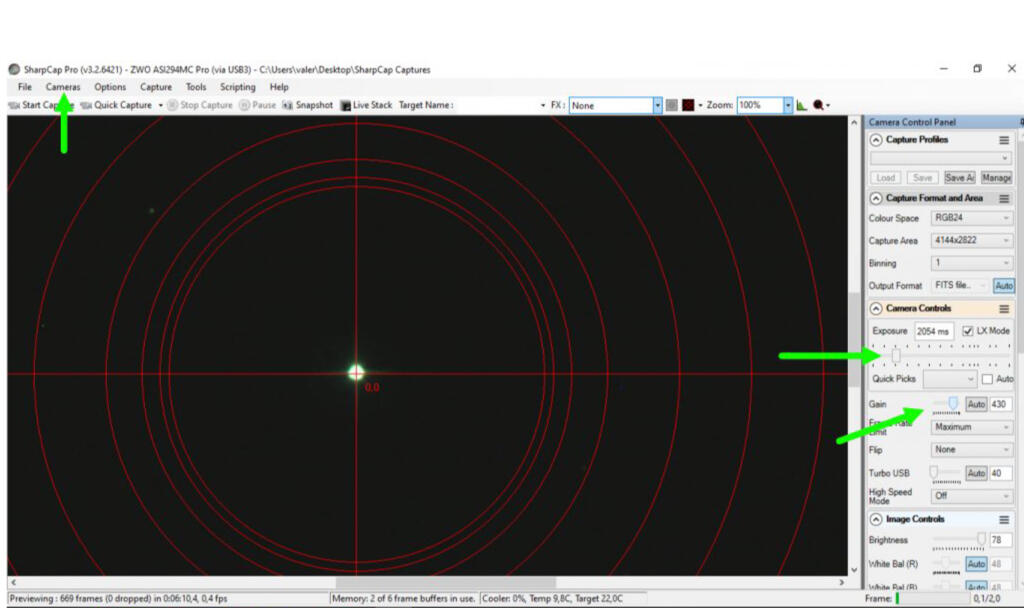
Activate your reticle (the red crosshair next to the Zoom function), and now use the arrow keys on your controller to move the selected star until it is perfectly centered in the crosshair. Once aligned, press ENTER.
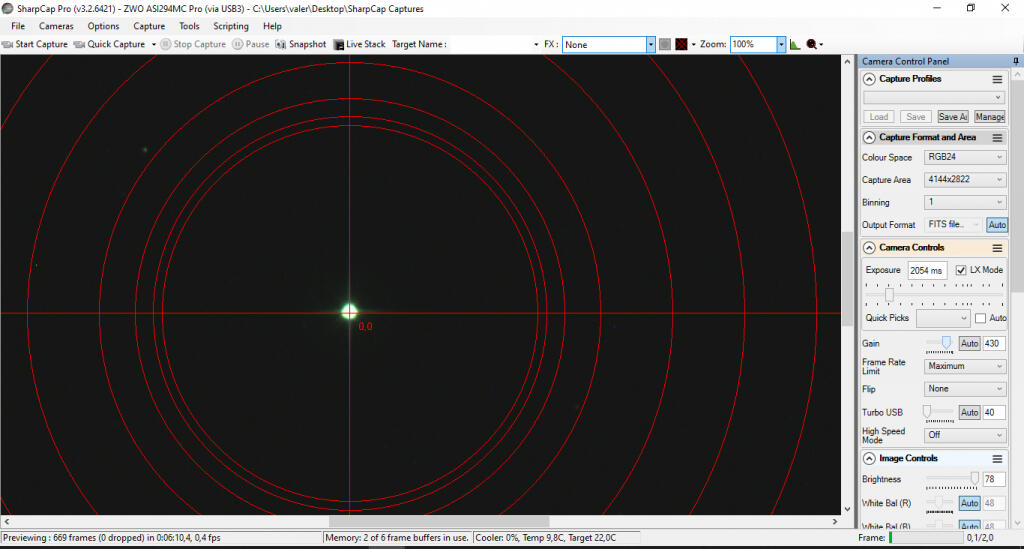
Repeat the same procedure with the second star.
Once this alignment is complete, the mount will provide, via the Hand Controller, some values indicating the polar error in degrees, minutes, and seconds. These values will show how far off the alignment is in AZ (Azimuth) and EL (Elevation).
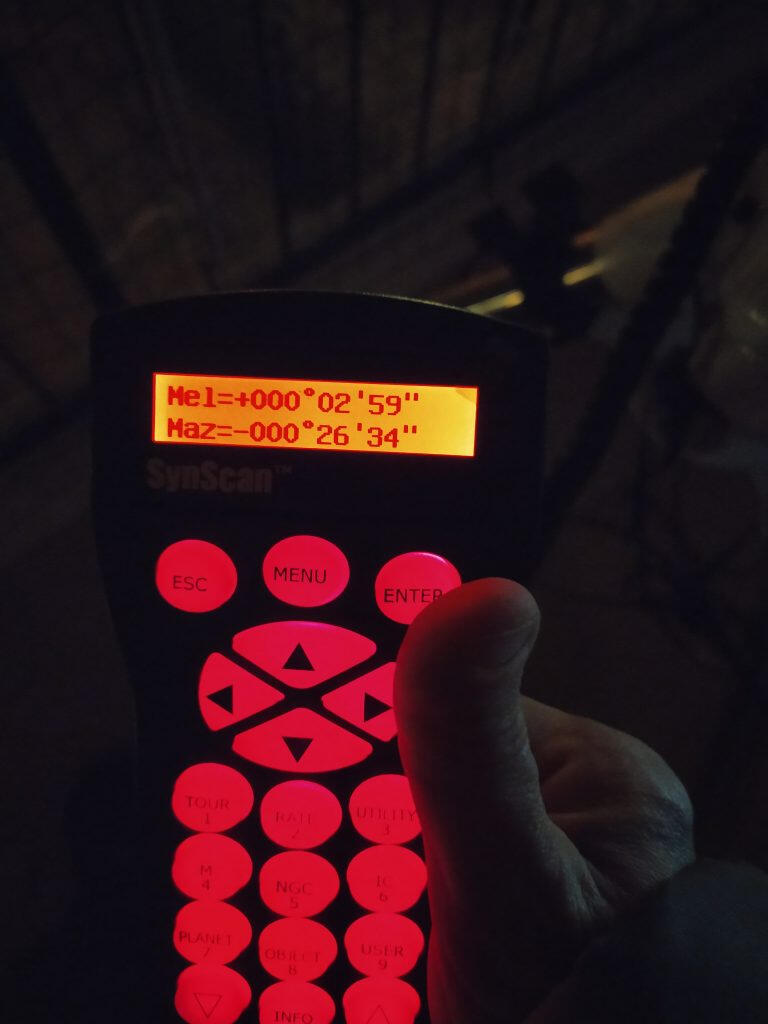
Let's read the values: it tells us that we have an error of 2 minutes and 59 seconds in Elevation and 26 minutes and 34 seconds in Azimuth.
Reducing AZ EL Error
Here is the procedure to minimize this error. By scrolling through the menu using the down arrows on the Hand Controller, we will find the Polar Alignment tool.
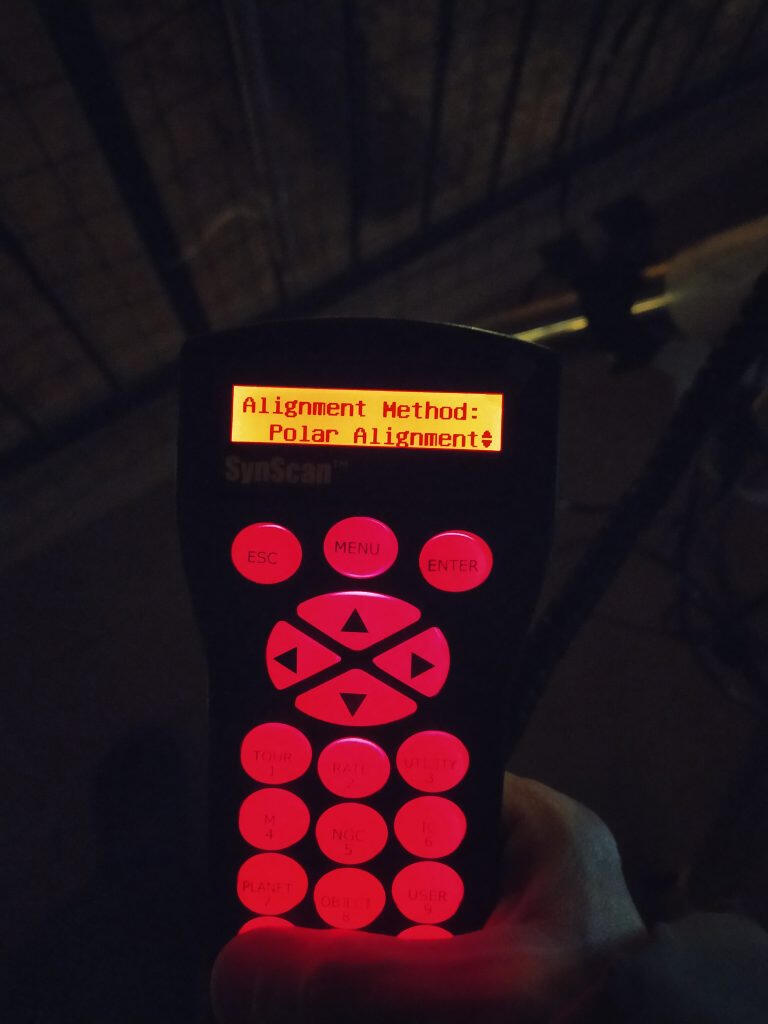
Press ENTER, and it will prompt us to choose a star on which it will apply the corrections we provide by adjusting Azimuth and Elevation.
In our case, we will select Deneb again.
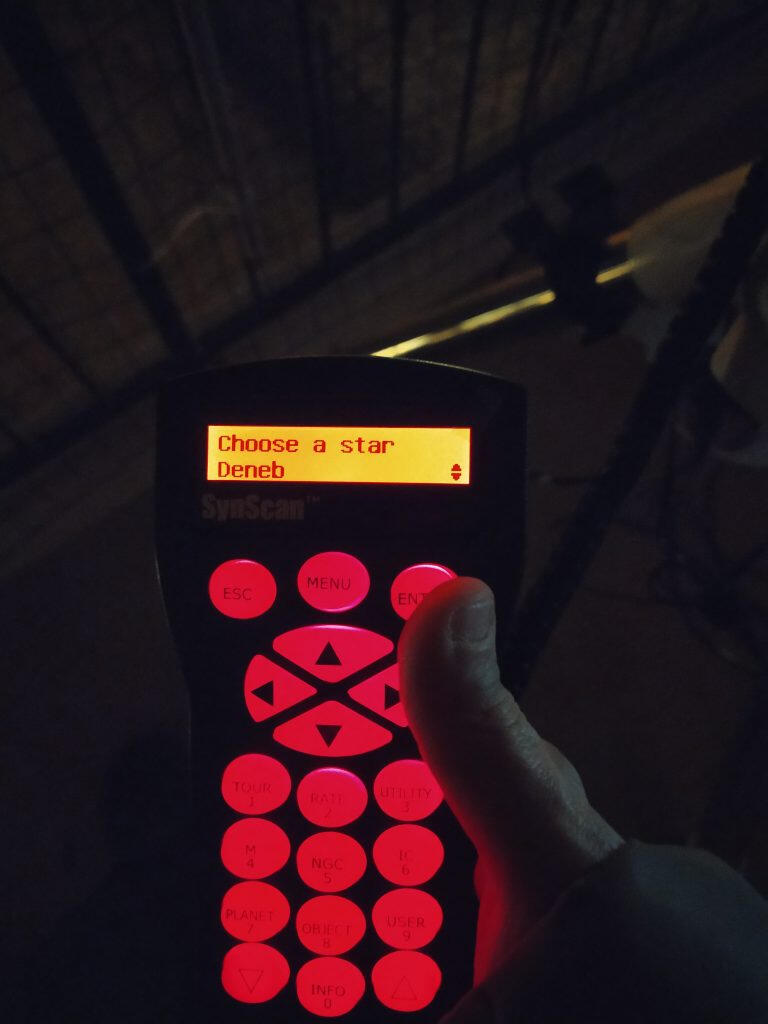
Using the arrows on the Hand Controller, we will bring it back to the center of the SharpCap crosshair.

Now, by pressing ENTER, the Polar Alignment tool will shift our star by an amount equal to the Elevation error calculated after the 2/3-star alignment—in our case, 2 minutes and 59 seconds.

On the SharpCap crosshair, we will see this situation (refer to the figure).
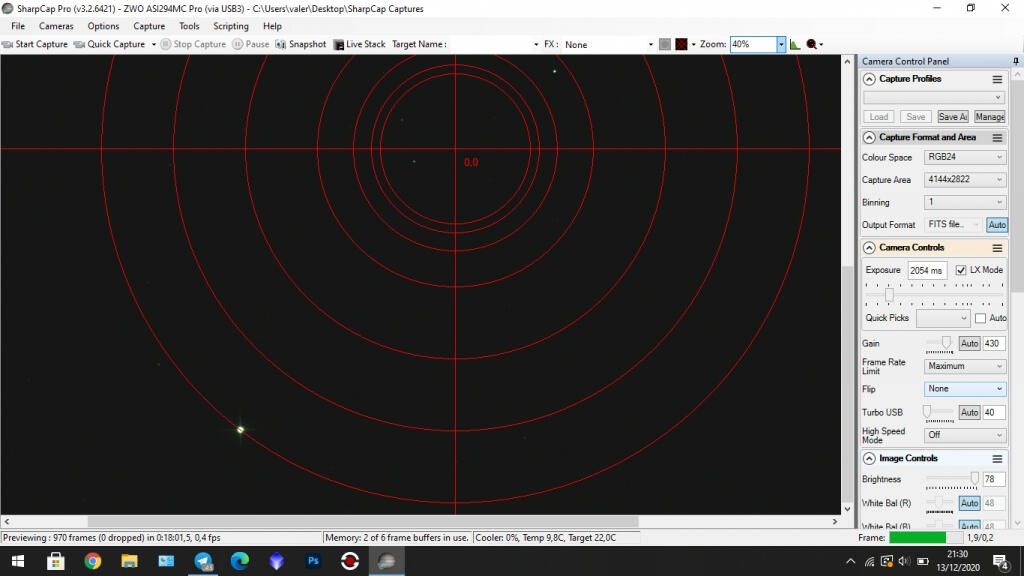
As you can see, the star has been shifted. Now, by adjusting ONLY the Elevation adjustment screws (refer to the figure), we will aim to bring the star back to the center of the SharpCap crosshair.

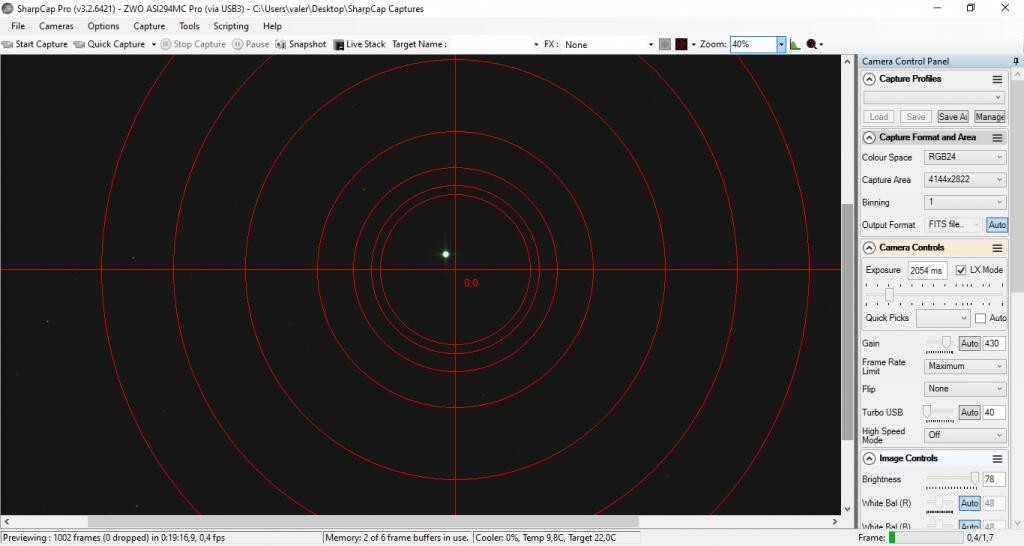
Don't worry if we can't bring it precisely to the center. Remember, we are correcting only one axis at a time, so the important thing is to get as close to the center as possible.
Once completed, the Hand Controller will register the adjustment and prompt us to make the correction in Azimuth as well.
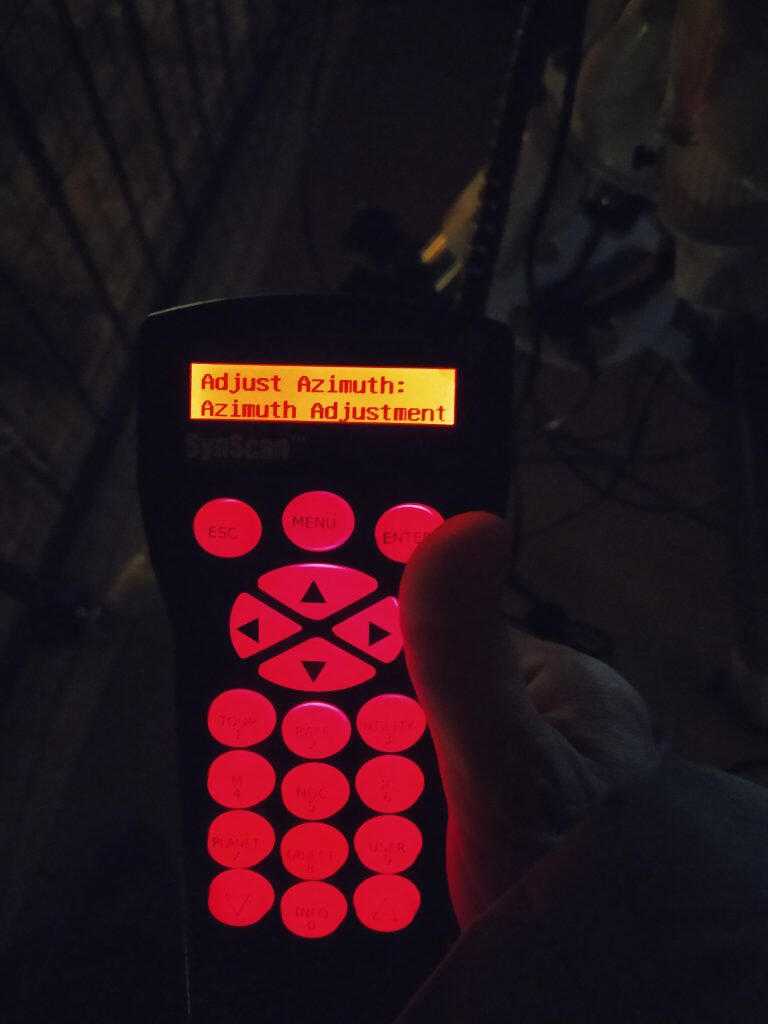
The Polar Alignment tool will shift our star by an amount equal to the Azimuth error calculated after the 2/3-star alignment in our case, 26 minutes and 34 seconds.Tip: Since this is a very large shift, our reference star will likely have moved out of the camera's field of view. To assist with the adjustments, it is advisable to have a finder scope mounted on the main tube to help guide the movements and bring the star back to the center of the crosshair.Repositioning the Star
To reposition the star and allow the mount to register the correction, this time we need to adjust the Azimuth adjustment screws (refer to the figure).
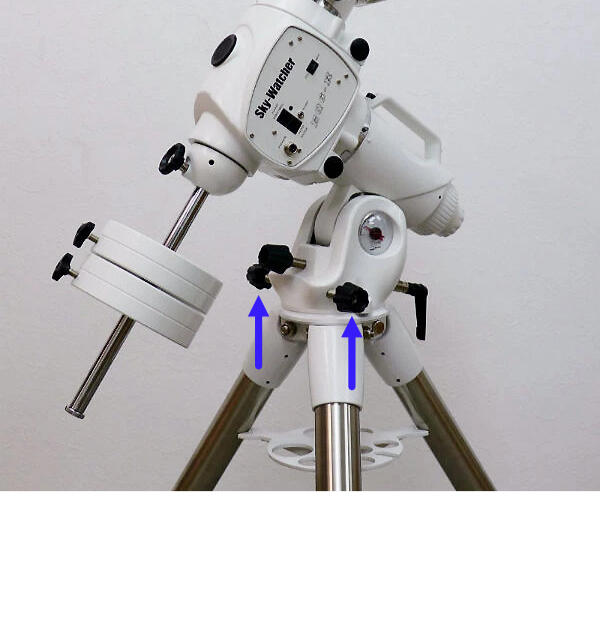
Again, we aim to bring the star as close as possible to the center of the crosshair. Once Azimuth has been adjusted, we can press ENTER on the Hand Controller to complete the correction phase.Now, we need to verify whether the polar alignment error has reached an acceptable value. This is checked by performing a new 2/3-star alignment.Personal Tip: I prefer to return the mount to its starting position (with the tube pointing North) by powering it off and restarting the system.
From the Hand Controller, scroll through the menus and select Park Scope, which will park the mount while retaining all the previously entered data.

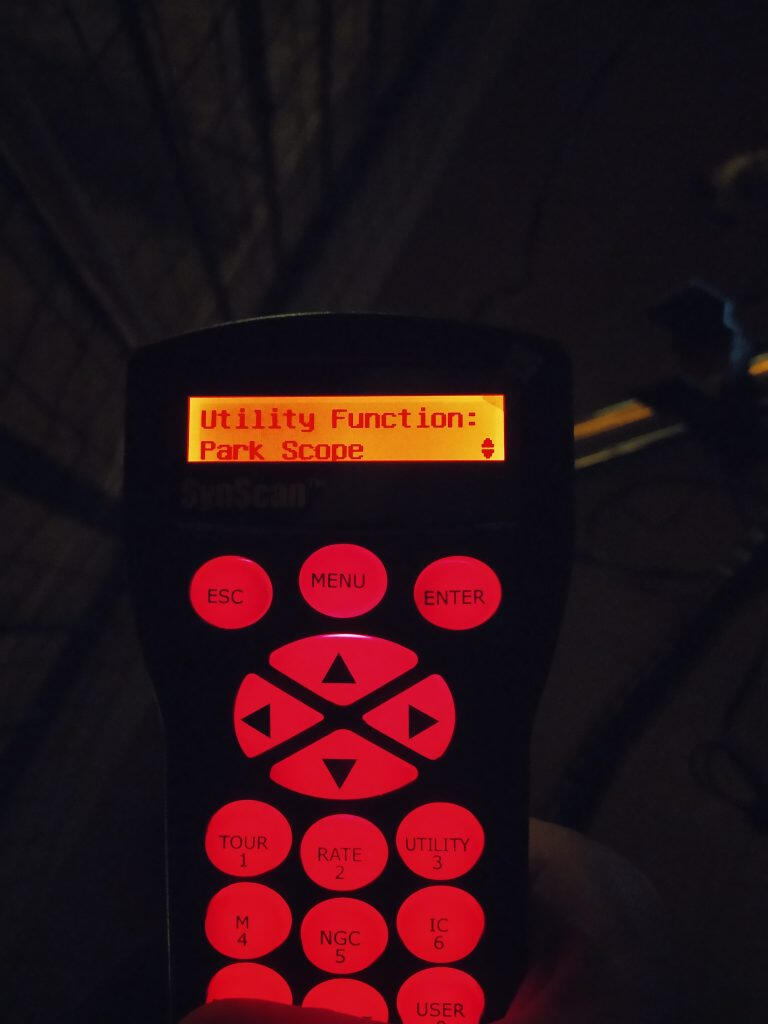
Turn off and restart the mount. The Hand Controller will ask if we want to restore the previous Park data. We will select Yes, recalling the configuration and simply confirming the date and time.
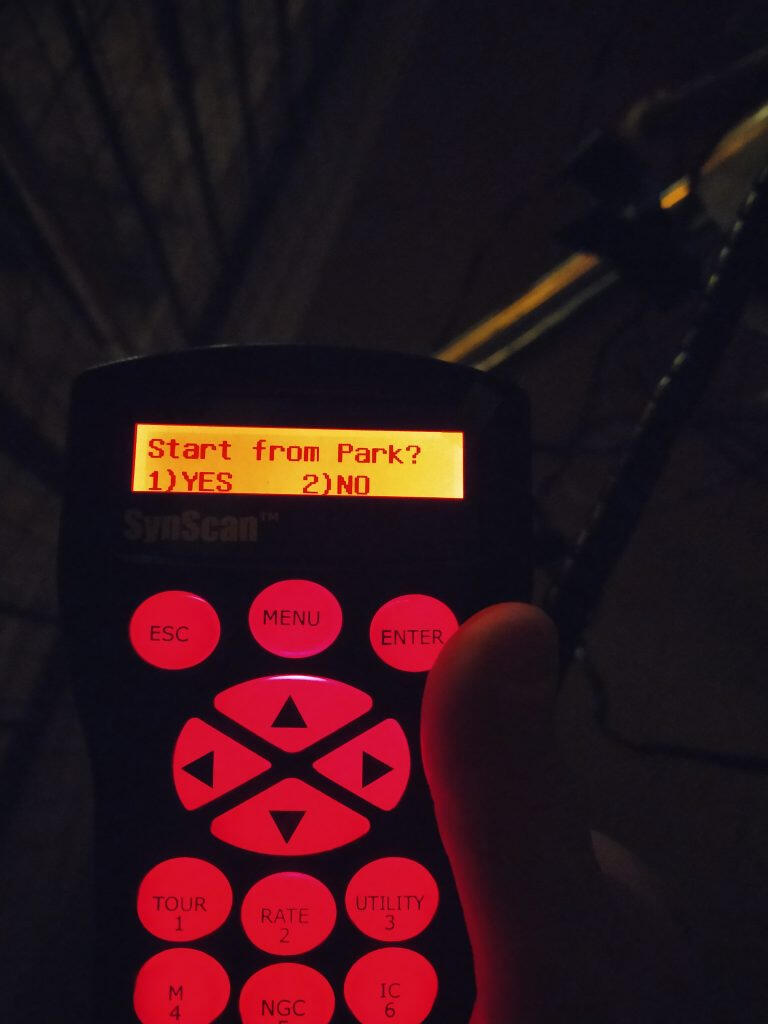
Once the data has been restored, use the selection arrows to scroll through the menu and choose "Setup". In the Setup menu, look for the option "Alignment".
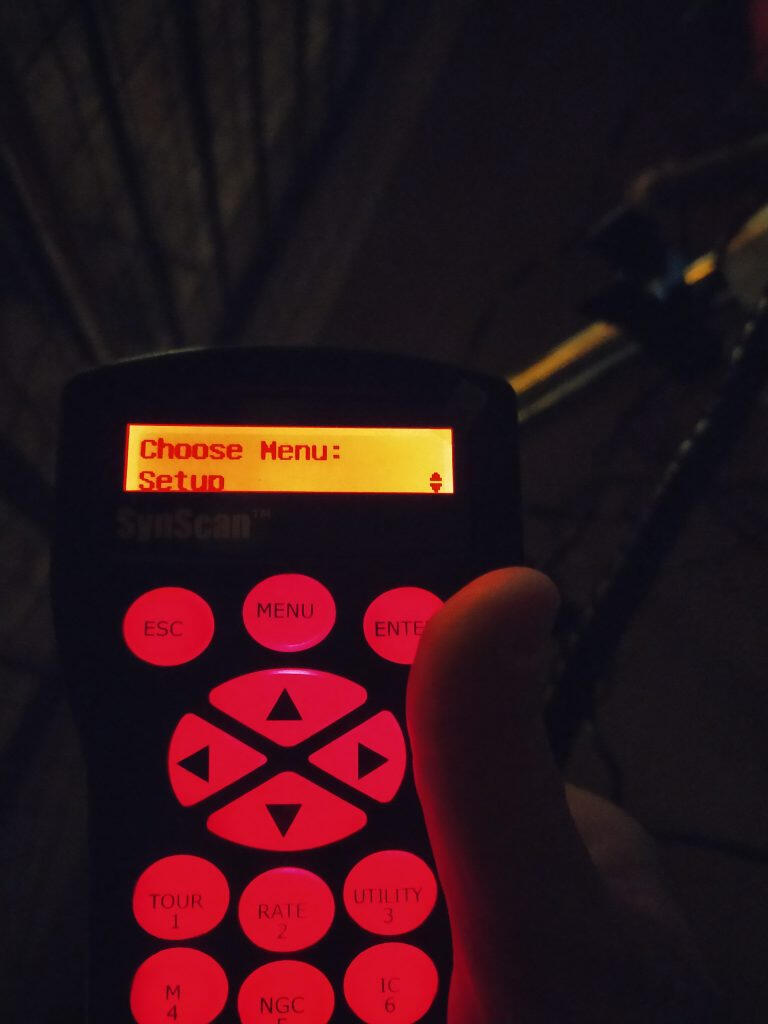

Verification of Polar Alignment Error Correction
At this stage, repeat a 2 or 3-star alignment to verify that the polar alignment error has been minimized. Once again, we will first point to Alpheratz and then to Deneb, following the same steps as outlined earlier.At the end of the process, check the Hand Controller to see the updated error values it provides.

As you can see, we achieved an excellent result given the initial conditions, and we managed to do so in just one pass. That said, if the result is not satisfactory, the entire procedure can be repeated multiple times to achieve better accuracy.With values like these, I can take 600-second guided exposures with image deviation below 5%. Of course, mechanical errors or other variables may come into play, but overall, I’ve been using this system from my balcony with good results for about two and a half years.This tutorial comes from my personal experience as a beginner who needed to align to the polar axis without being able to see it and with limited guidance available online.
Nowadays, there are many programs available, both free and paid, for polar alignment. Therefore, I recommend my method especially to beginners who are entering the world of astrophotography for the first time.This approach may be simpler for those who want to start aligning to the pole in an assisted way without relying on software. It’s particularly useful for those photographing with a DSLR camera without using a PC or automated systems like ASIair, Stellarmate, and similar tools.Remember, if something goes wrong, don’t blame me! 😄
Clear skies! 🌌
Plate solving
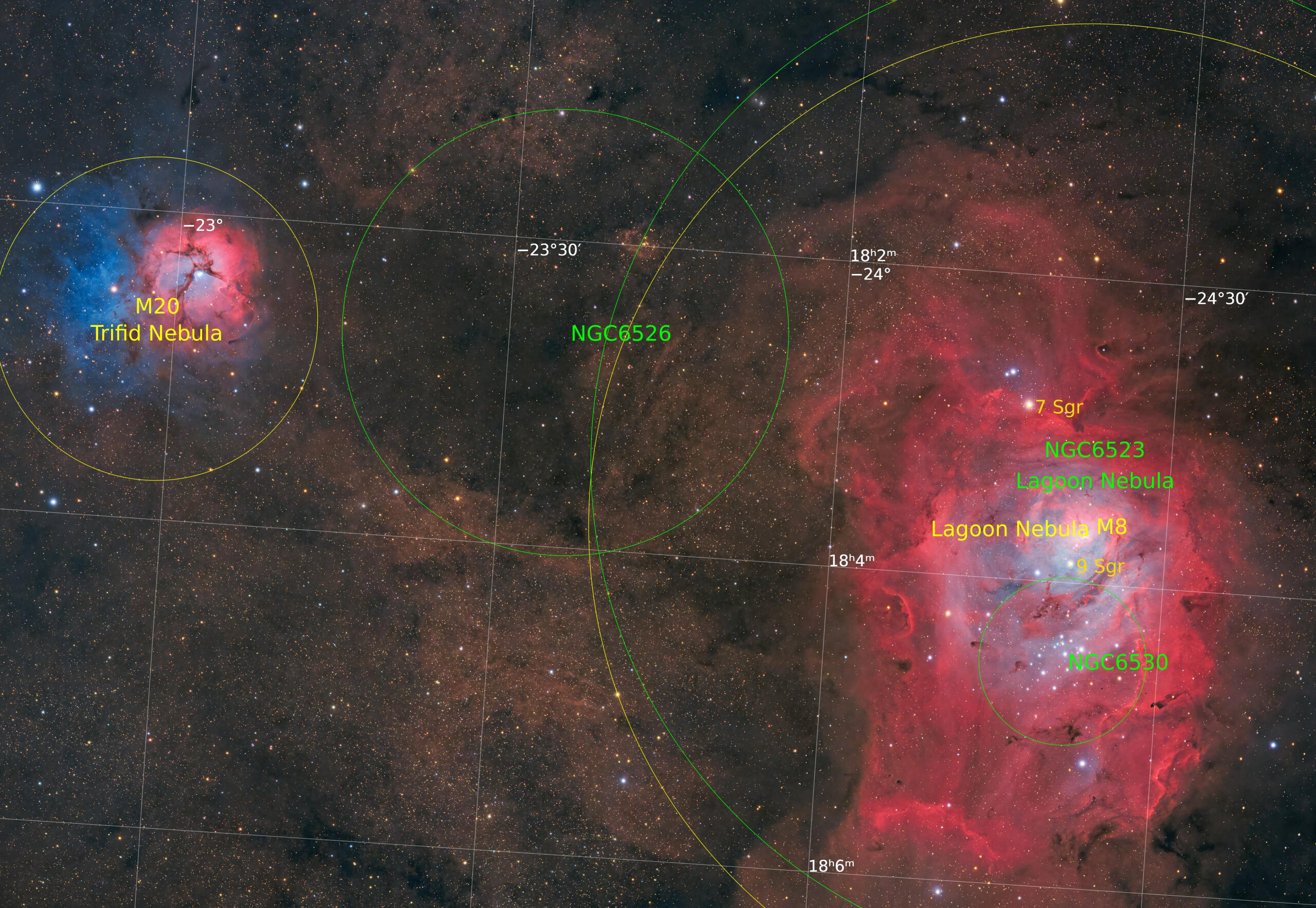
What is Plate Solving?Plate solving is the process of determining the exact celestial coordinates of an astronomical image by matching the stars visible in the photo with a reference star catalog. This process assigns precise Right Ascension (RA) and Declination (DEC) values to each pixel in the image, allowing astronomers and astrophotographers to know exactly which part of the sky they captured.Plate solving is essential for aligning telescopes, stacking images, conducting photometric and astrometric measurements, and integrating observations into large astronomical databases.
Plate solving is widely used for several applications in astronomy, including:✅ Automatic Object Identification – Helps in recognizing stars, galaxies, nebulae, and other celestial bodies in an image without manual searching.
✅ Precise Image Alignment – Essential for astrophotographers stacking multiple images for better clarity and detail.
✅ Astrometric Calibration – Enables the transformation of an image’s pixel grid into a real celestial coordinate system, making scientific measurements possible.
✅ Telescope Go-To Correction – Used in robotic and guided telescopes to ensure they are accurately pointing at the desired celestial target.
✅ Variable Star & Transient Detection – Helps in tracking changes in brightness, motion, and the discovery of new transient objects such as supernovae or asteroids.Metadata Generated by Plate Solving
Once an image is plate solved, several important metadata fields are added to the file. These metadata help scientists and astrophotographers understand and use the image more effectively.1️⃣ Astrometric Metadata (derived from plate solving)
- Right Ascension (RA) & Declination (DEC) – The central celestial coordinates of the image.
- Field of View (FOV) – The angular area of the sky covered by the image, typically given in arcminutes or degrees.
- Pixel Scale – The resolution of the image in arcseconds per pixel, useful for scientific measurements.
- Image Orientation – The rotation angle of the image relative to celestial north.
- World Coordinate System (WCS) – A mathematical model that transforms pixel coordinates into real celestial coordinates.2️⃣ Observation Metadata (often included in FITS headers)
- Date and Time of Observation (UTC or Julian Date)
- Exposure Time – The duration of light collection for the image.
- Telescope and Camera Details – The instrument used, including aperture, focal length, and sensor type.
- Filters Used – Such as Hα, LRGB, or narrowband filters, which affect the wavelength of light captured.3️⃣ Photometric Metadata (if applicable)
- Magnitude Calibration – If known, the brightness of detected stars can be cross-referenced with catalog data.
- Reference Star Catalog – The database (e.g., Gaia, UCAC4, Tycho-2) used for solving.After plate solving, the metadata are stored in astronomical image files, most commonly in:- FITS format (Flexible Image Transport System) – The standard file format in professional astronomy, which includes an extensive header section for metadata.
- Annotated JPEG/PNG files – If plate solving is done with a tool like Astrometry.net, it may return a labeled version of the image with coordinates overlaid.To access metadata in a FITS file, you can use software like:SAOImage DS9 (for viewing FITS files)Aladin Sky Atlas (for catalog integration)Astropy (Python library) (for automated data extraction)How to Try Plate Solving?
If you have an astrophotography image, you can upload it to Astrometry.net, a free online tool that automatically plate solves your image and provides astrometric metadata.Alternatively, advanced users can use local plate solving software like:
- Astap (Astrometric Stacking Program)
- PixInsight ImageSolver script
Astronomy Tools
Astronomy.tools is an online platform designed to help amateur and professional astronomers plan their observations, choose the right equipment, and analyze the performance of optical systems in astrophotography. The site offers interactive calculators and tools to simulate field of view, resolution, and image quality for different telescopes and cameras.Main Features of Astronomy Tools
1️⃣ CCD Suitability Calculator
- Calculates image sampling in arcsec/pixel based on:
- Pixel size of the sensor (in µm)
- Telescope focal length (in mm)
- Atmospheric seeing (in arcseconds)
- Provides an image quality assessment:
- Oversampling (too much detail, loss of light)
- Undersampling (pixelated image, loss of detail)
- Good Quality (optimal balance between pixels and seeing)Useful for:
✅ Determining if a CCD camera is suitable for a given telescope.
✅ Optimizing settings for planetary or deep-sky imaging.🔗 Calculator link: CCD Suitability Calculator2️⃣ Field of View (FOV) Calculator
- Simulates the field of view of a telescope + camera combination.
- Shows how a celestial object will appear (e.g., Moon, Orion Nebula, Andromeda Galaxy).
- Allows comparison of multiple configurations to find the ideal magnification.Useful for:
✅ Planning astrophotography and selecting the right sensor/telescope.
✅ Avoiding incorrect framing (field too wide or too narrow).🔗 Calculator link: FOV CalculatorWhy Use Astronomy Tools?
✔️ Free and accessible from any device.
✔️ Interactive: test different configurations in real-time.
✔️ For everyone: useful for amateurs and professional deep-sky photographers.
✔️ Easy to use: no installation required, everything is online.Want to optimize your gear? Try the calculators at Astronomy Tools or use the window below

























































































